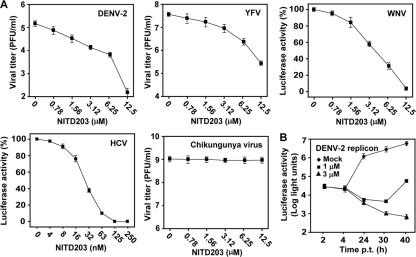FIG. 3.
Antiviral spectrum and mode-of-action analysis. (A) Vero cells were infected with the indicated viruses at an MOI of 0.1 and treated immediately with NITD203. For DENV-2 and YFV, culture medium was collected at 48 h postinfection and measured for viral titers using plaque assays. For Chikungunya virus, culture medium was collected at 22 h postinfection and measured for viral titer. For WNV, Vero cells were infected with virus-like particles (containing a luciferase replicon) at an MOI of about 0.1; the infected cells were assayed for luciferase activity at 24 h postinfection; relative luciferase activities were presented, with the level for the mock-treated replicon cells set as 100%. For HCV, Huh-7 cells carrying a luciferase replicon HCV (5) were incubated with NITD203 and assayed for luciferase activities at 48 h posttreatment. Average results and standard deviations (n = 3) are presented. (B) Transient DENV-2 replicon assay. A luciferase reporter replicon of DENV-2 was transfected into BHK-21 cells. The transfected cells were immediately incubated with the indicated concentrations of the compound and measured for luciferase activities at various time points posttransfection (p.t.). The effects of compound (1 μM and 3 μM) on viral translation and RNA synthesis were quantified by the luciferase signals at 2 to 4 h p.t. and at 24 to 40 h p.t., respectively. Average results and standard deviations (n = 3) are presented.

